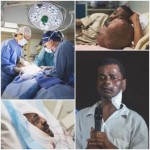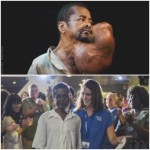Salama from Madagascar
Earlier this year, Mercy Ships volunteer surgeons removed the largest tumor (7.46 kg or 16.45 lbs) they had ever seen from a kind, 55-year-old man named Sambany. Much bigger than Alimou for those who remember my friend from Guinea in 2008. He had walked for two days to get to the Africa Mercy. His operation took 12 hours.
Mercy Ships created this video about him. I think the obstacles Sambany faced are similar to those that many Mercy Ships patients must overcome to access the medical care they need.
I am excited to share his story with you today: www.mercyships.org/sambany. – for the video – below is the story Communications wrote.
SAMBANY, A “DEAD MAN” LIVES Created by Nancy Predaina
The man trembled up our gangway and did something extraordinary . . . he changed our lives while we were changing his life.
Over the next few weeks, his name was spoken across the Africa Mercy’s eight decks, thousands of tears and prayers ascended to God, and social media exploded with his story. What was so special about Sambany?
Around 36 years ago, a tumor began to consume Sambany’s life. It became a monstrous burden, weighing 7.46 kg (16.45 lbs) – equivalent to two extra heads. After nearly three decades as a maxillofacial surgeon, Dr. Gary Parker, Chief Medical Officer, says, “It’s one of the biggest tumors of this type that I’ve seen.”
The tumor caused unrelenting discomfort. Sometimes it felt “hot like fire.” Sambany said, “I cannot sleep at night, and even during the day. It heated me up. When walking, it’s too heavy. I have to hold it.”
The tumor was also an emotional burden. Family and friends rejected him, mocked him, laughed at him, shunned him. Some thought his condition was contagious. Harsh words were flung at him: “Why are you still alive? No one can help!”
Hopelessness defined his life. The search for help required traveling hundreds of kilometers and included ten hospitals (only three of which had surgeons) and a witch doctor … with no success. Sambany’s poverty blocked any other option. His despair reached new depths. He says, “I was waiting to die. I could not do anything. Every day, I was just waiting to die.”
So, Sambany’s world shrank to the size of his house, his only place of safety and peace.
Eventually, he became so weak that his life became a monotonous cycle of waking, sleeping eating. He felt useless, and it was hard to watch his family laboring in the rice fields while he wasted away. They were poor, and money spent on trying to help him was money unavailable for food.
Sambany’s main companion was the radio. One day he heard an announcement that resurrected hope: a hospital ship that could treat tumors for free was coming to Madagascar. In spite of his weakness, Sambany told his family, “Die or survive, I want to go!”
It was a journey that only a desperate man would attempt. The closest road was several days away; the ship was hundreds of kilometers away. Sambany struggled to walk around his house. How could he survive such a journey? But his family recognized his desperation and determination. They sold a rice field to pay for the journey. Five people took turns carrying him on their backs for two days. Then Sambany endured a painful six-hour taxi ride … but he made it.
Due to multiple health concerns, Sambany’s surgery would be extremely high-risk. For almost two weeks, he rested as the medical team determined the best course of action.
Meanwhile, his story spread throughout the ship. It made its way into our community meeting, when all were asked to pray. It appeared as signs on doors, asking us to pray and to give blood. It lent its voice to concerned requests for updates. It travelled into people’s dreams, dampened many a tissue with tears, and prompted some to go hungry as they fasted for this stranger from a country far from their own. Sambany penetrated our lives.
Then, with one word, Sambany’s entire life was changed. After a lifetime of hearing, “No, no, no,” he was delighted when the medical team said yes to performing the difficult surgery. Sambany was well aware of the risks. “I know without surgery I will die. I know I might die in surgery, but I already feel dead inside from the way I’m treated. I choose to have surgery.”
The surgery took over half a day, and over twice of his body’s volume of blood was lost and replaced. Our crew, our living blood bank, literally poured life into Sambany. The blood of seventeen people from six nations now runs through his veins.
 Dr Gary described the surgery: “Oftentimes, in operations, you have high-stress moments where you’re in the middle of something – where, in that moment, if something goes wrong, you could lose the patient from a severe hemorrhage or something. With Sambany, it was pretty much high pressure the whole twelve hours of the surgery.”
Dr Gary described the surgery: “Oftentimes, in operations, you have high-stress moments where you’re in the middle of something – where, in that moment, if something goes wrong, you could lose the patient from a severe hemorrhage or something. With Sambany, it was pretty much high pressure the whole twelve hours of the surgery.”
The end result? Sambany was finally free from the burden that had weighed him down for nearly two-thirds of his life! And the ship exploded with people praising God. We had helped transform Sambany, and he had transformed us.
A group of us watched breathlessly as Sambany looked at himself in a hand-held mirror … seeing himself for the first time without his tumor. With his head wrapped carefully in bandages, he looked into the mirror and said, “I like it. I am happy.” Later, he added, “I am free from my disease. I’ve got a new face. I am saved!”
A little over a month after his arrival, Sambany and his faithful grandson Flavy, made a special appearance at our weekly Community Meeting, triggering thunderous applause. What a “red carpet” moment! Everyone rose to their feet to honor this courageous man. Together, we had fought a battle against his death . . . and, by the grace of God, had won.
Dr. Gary says, “I think that every human being has the right to look human. To be treated as human. To have a place at the table of the human race. And when you have been deprived that seat, and it’s offered to you again . . . to be able to re-enter the human race and to look like everyone else . . . that’s a fantastic thing.”
Story by Eunice Hiew / Edited by Nancy Predaina / Photos by Katie Keegan, Ruben Plomp, Justine Forrest, Josh Callow
Because of you all my donors, I am able to be a part of Sambany’s story and many others. This past Sunday at our ward service, I sat with Sambany and as we used the Simply the Story method of sharing Bible stories, there is participation and he was participating fully.
Today Sambany is looking great and healing nicely. “My heart is very, very happy. I’m very happy. I’m just happy,” he says. You were part of that. Thank you for all of the ways you support the work I am doing with Mercy Ships!

